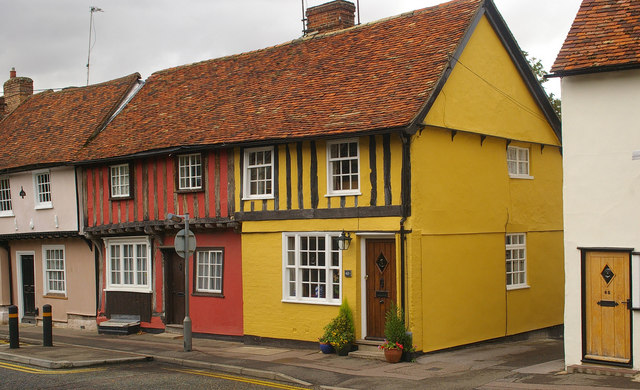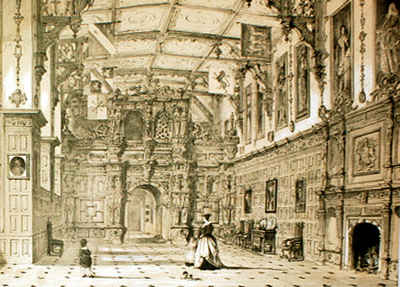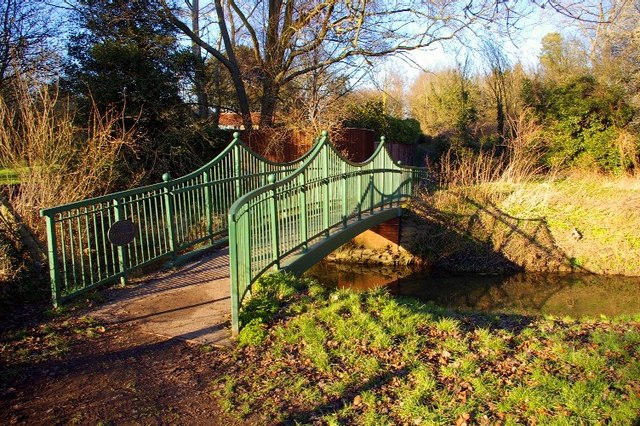|
Stort Navigation
The Stort Navigation is the canalised section of the River Stort running from the town of Bishop's Stortford, Hertfordshire, downstream to its confluence with the Lee Navigation at Feildes Weir near Rye House, Hoddesdon, Hertfordshire. History With the growth of the malt trade in Bishop's Stortford in the early eighteenth century, attention turned to providing better transport facilities. The River Stort joined the River Lea, and the malt trade at Ware had benefitted from improvements made on that river. A similar solution was therefore sought for the Stort, and a public meeting was held on 11 December 1758. The chief promoter seems to have been Thomas Adderley. A bill was duly submitted to parliament, and became an Act of Parliament in March 1759. It was entitled ''An Act for making the River Stort navigable, in the counties of Hertford and Essex, from the New Bridge, in the town of Bishop Stortford, into the River Lea, near a Place called the Rye, in the county of Hertford''. ... [...More Info...] [...Related Items...] OR: [Wikipedia] [Google] [Baidu] |
Thomas Yeoman
Thomas Yeoman (1709 or 1710 – 23 January 1781) was a millwright, surveyor and civil engineer who played a significant part in the early industrial revolution and became the first president of the first engineering society in the world, the Smeatonian Society of Civil Engineers, Society of Civil Engineers, now known as the Smeatonian Society of Civil Engineers. Northampton Although his origin and early life are obscure, he was probably born in Somerset and is first known as a wheelwright skilled in "turning iron & Brass, & making machinery for grinding" recruited by Edward Cave to operate a water-powered cotton Marvell's Mill, roller-spinning mill at Northampton in 1741 under licence from Lewis Paul. He was here with his wife Sarah and their son James. Yeoman established himself as a millwright constructing machinery such as ventilators invented by the clergyman Stephen Hales and began to take an active part in Northampton's business. Yeoman was a notable member of the local Ba ... [...More Info...] [...Related Items...] OR: [Wikipedia] [Google] [Baidu] |
Matthew Boulton
Matthew Boulton (; 3 September 172817 August 1809) was an English manufacturer and business partner of Scottish engineer James Watt. In the final quarter of the 18th century, the partnership installed hundreds of Boulton & Watt steam engines, which were a great advance on the state of the art, making possible the mechanisation of factories and mills. Boulton applied modern techniques to the minting of coins, striking millions of pieces for Britain and other countries, and supplying the Royal Mint with up-to-date equipment. Born in Birmingham, he was the son of a Birmingham manufacturer of small metal products who died when Boulton was 31. By then Boulton had managed the business for several years, and thereafter expanded it considerably, consolidating operations at the Soho Manufactory, built by him near Birmingham. At Soho, he adopted the latest techniques, branching into silver plate, ormolu and other decorative arts. He became associated with James Watt when Watt's ... [...More Info...] [...Related Items...] OR: [Wikipedia] [Google] [Baidu] |
Hockwold Cum Wilton
Hockwold cum Wilton (''"Hock/mallow wood and willow-tree farm/settlement"'') is 10 miles west of Thetford, Norfolk, England and is in the borough of King's Lynn and West Norfolk. It is located near several USAF airbases, notably RAF Lakenheath and RAF Mildenhall. It is situated on the boundary between the geographical areas of the Breckland – a region of sandy heathland now largely forested – and the flat, low-lying Fens, with some characteristics of both. The village is the location of the primary campus of Iceni Academy. Previously this was Hockwold Primary School. The village has two churches ( St Peter's, now redundant and cared for by the Churches Conservation Trust, and St James') and a Methodist chapel. History An important Roman hoard of silver tableware and coins was found in Hockwold in 1962. It is now part of the Roman-British collections at the British Museum. Originally, the village was located next to the river. However, after the Black Death infected the vi ... [...More Info...] [...Related Items...] OR: [Wikipedia] [Google] [Baidu] |
River Little Ouse
The River Little Ouse is a river in the east of England, a tributary of the River Great Ouse. For much of its length it defines the boundary between Norfolk and Suffolk. It rises east of Thelnetham, close to the source of the River Waveney, which flows eastwards while the Little Ouse flows west. The village of Blo' Norton owes its name to the river: it was earlier known as ''Norton Bell-'eau'', from being situated near this "fair stream". In this area the river creates a number of important wetland areas such as at Blo' Norton and Thelnetham Fens, and areas managed by the Little Ouse Headwaters Project. The course continues through Rushford, Thetford, Brandon, and Hockwold before the river joins the Great Ouse north of Littleport in Cambridgeshire. The total length is about . The river is navigable from the Great Ouse to a point above Brandon. Origins A distinctive feature of the headwaters of the Little Ouse and the Waveney is the valley in which they flow; the Little Ou ... [...More Info...] [...Related Items...] OR: [Wikipedia] [Google] [Baidu] |
John Rennie The Elder
John Rennie FRSE FRS (7 June 1761 – 4 October 1821) was a Scottish civil engineer who designed many bridges, canals, docks and warehouses, and a pioneer in the use of structural cast-iron. Early years He was born the younger son of James Rennie, a farmer near Phantassie, near East Linton, East Lothian, Scotland. John showed a taste for mechanics at a very early age, and was allowed to spend much time in the workshop of Andrew Meikle, a millwright and the inventor of the threshing machine, who lived at Houston Mill on the Phantassie estate. After receiving a normal basic education at the parish school of Prestonkirk Parish Church, he was sent to the burgh school at Dunbar, and in November 1780 he matriculated at the University of Edinburgh, where he remained until 1783. His older brother George remained to assist in the family agricultural business. Rennie worked as a millwright to have established a business. His originality was exhibited by the introduction of cast i ... [...More Info...] [...Related Items...] OR: [Wikipedia] [Google] [Baidu] |
Bedford Level Corporation
The Bedford Level Corporation (or alternatively the Corporation of the Bedford Level) was founded in England in 1663 to manage the draining of the Fens of East Central England. It formalised the legal status of the Company of Adventurers previously formed by the Duke of Bedford to reclaim 95,000 acres of the Bedford Level. History The low-lying land of East Central England, known as the Fens, consisted traditionally of semi-continuous marshland and peat bog interspersed with isolated patches of higher ground. Agriculture has only been made possible by a co-ordinated system of drainage ditches. During medieval times this was controlled by the great monasteries in the area but fell into disrepute after the dissolution of the monasteries. By the 1600s the general drainage situation was so bad that King Charles I invited Cornelius Vermuyden, the Dutch engineer, to devise a scheme to drain the Great Fen. The Bedford Level The Great Fen, lying between the Wash and Cambridge, is more ... [...More Info...] [...Related Items...] OR: [Wikipedia] [Google] [Baidu] |
Saffron Walden
Saffron Walden is a market town in the Uttlesford district of Essex, England, north of Bishop's Stortford, south of Cambridge and north of London. It retains a rural appearance and some buildings of the medieval period. The population was 15,504 at the 2011 census. History Archaeological evidence suggests continuous settlement on or near the site of Saffron Walden from at least the Neolithic period. It is believed that a small Romano-British settlement and fort – possibly in the area round Abbey Lane – existed as an outpost of the much larger settlement of Cestreforda to the north. After the Norman invasion of 1066, a stone church was built. Walden Castle, dating from about 1140, may have been built on pre-existing fortifications. A priory, Walden Abbey, was founded under the patronage of Geoffrey de Mandeville, 1st Earl of Essex about 1136, on the site of what is now Audley End House. The abbey was separated from Walden by Holywell Field. After the dissolution of the m ... [...More Info...] [...Related Items...] OR: [Wikipedia] [Google] [Baidu] |
Kings Lynn
King's Lynn, known until 1537 as Bishop's Lynn and colloquially as Lynn, is a port and market town in the borough of King's Lynn and West Norfolk in the county of Norfolk, England. It is located north of London, north-east of Peterborough, north-north-east of Cambridge and west of Norwich. History Toponymy The etymology of King's Lynn is uncertain. The name ''Lynn'' may signify a body of water near the town – the Welsh word means a lake; but the name is plausibly of Anglo-Saxon origin, from ''lean'' meaning a tenure in fee or farm. As the 1085 Domesday Book mentions saltings at Lena (Lynn), an area of partitioned pools may have existed there at the time. Other places with Lynn in the name include Dublin, Ireland. An Dubh Linn....the Black Pool. The presence of salt, which was relatively rare and expensive in the early medieval period, may have added to the interest of Herbert de Losinga and other prominent Normans in the modest parish. The town was named ''Len '' (Bisho ... [...More Info...] [...Related Items...] OR: [Wikipedia] [Google] [Baidu] |
Baron Howard De Walden
Baron Howard de Walden is a title in the Peerage of England. It was created by Hereditary peer#Writs of summons, writ of summons in 1597 by Queen Elizabeth I for Thomas Howard, 1st Earl of Suffolk, Admiral Lord Thomas Howard, a younger son of Thomas Howard, 4th Duke of Norfolk, by his second wife, the Honourable Margaret Audley, daughter of Thomas Audley, 1st Baron Audley of Walden. History The title was reputedly granted for the Admiral's role in the defeat of the Spanish Armada in 1588. He subsequently went on to obtain the title of Earl of Suffolk from Elizabeth I's successor, King James VI and I, James I, which latter title continues in his male-line descendants. However, the barony of Howard de Walden eventually passed out of the Howard family with the death in 1688 of James Howard, 3rd Earl of Suffolk, and it came briefly to the 4th Earl of Bristol before passing in 1803 to his great-grandson, the four-year-old Charles Augustus Ellis. The title actually fell into abeyanc ... [...More Info...] [...Related Items...] OR: [Wikipedia] [Google] [Baidu] |
Audley End
Audley End House is a largely early 17th-century country house outside Saffron Walden, Essex, England. It is a prodigy house, known as one of the finest Jacobean houses in England. Audley End is now one-third of its original size, but is still large, with much to enjoy in its architectural features and varied collections. The house shares some similarities with Hatfield House, except that it is stone-clad as opposed to brick.Hadfield, J. (1970). ''The Shell Guide to England''. London: Michael Joseph. It is currently in the stewardship of English Heritage but long remained the family seat of the Barons Braybrooke, heirs to the estate of whom retain a portion of the contents of the house, the estate, and the right to repurchase as an incorporeal hereditament. Audley End railway station is named after the house. History Audley End was the site of Walden Abbey, a Benedictine monastery that was dissolved and granted to the Lord Chancellor Sir Thomas Audley in 1538 by Henry VI ... [...More Info...] [...Related Items...] OR: [Wikipedia] [Google] [Baidu] |
River Granta
The River Granta is the name of two of the four tributaries of the River Cam, although both names are often used synonymously. The Granta starts near the village of Widdington in Essex, flowing north past Audley End House to merge with the other contributary Rhee, which is also commonly called River Cam, a mile south of Grantchester. From source to its confluence with the Rhee it is in length. A further tributary, also known as the Granta, runs from south of Haverhill to join the larger Granta south of Great Shelford. Another minor tributary is Bourn Brook which has its source near the village of Eltisley, west of Cambridge, running east through Caxton, Bourn and Toft to join the Cam at Byron's Pool. In many maps the river changes its name at the Silver Street Bridge in Cambridge and is called "Granta" above and "Cam" below it. In earlier times even the lower part of the Cam was also named the Granta, but after the name of the Anglo-Saxon town of Grantebrycge had bee ... [...More Info...] [...Related Items...] OR: [Wikipedia] [Google] [Baidu] |
Cambridge
Cambridge ( ) is a university city and the county town in Cambridgeshire, England. It is located on the River Cam approximately north of London. As of the 2021 United Kingdom census, the population of Cambridge was 145,700. Cambridge became an important trading centre during the Roman and Viking ages, and there is archaeological evidence of settlement in the area as early as the Bronze Age. The first town charters were granted in the 12th century, although modern city status was not officially conferred until 1951. The city is most famous as the home of the University of Cambridge, which was founded in 1209 and consistently ranks among the best universities in the world. The buildings of the university include King's College Chapel, Cavendish Laboratory, and the Cambridge University Library, one of the largest legal deposit libraries in the world. The city's skyline is dominated by several college buildings, along with the spire of the Our Lady and the English Marty ... [...More Info...] [...Related Items...] OR: [Wikipedia] [Google] [Baidu] |




.jpg)
.jpg)




